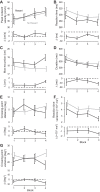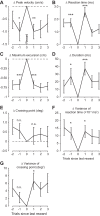Vigor of reaching movements: reward discounts the cost of effort
- PMID: 29537911
- PMCID: PMC6734091
- DOI: 10.1152/jn.00872.2017
Vigor of reaching movements: reward discounts the cost of effort
Abstract
Making a movement may be thought of as an economic decision in which one spends effort to acquire reward. Time discounts reward, which predicts that the magnitude of reward should affect movement vigor: we should move faster, spending greater effort, when there is greater reward at stake. Indeed, saccade peak velocities are greater and reaction-times shorter when a target is paired with reward. In this study, we focused on human reaching and asked whether movement kinematics were affected by expectation of reward. Participants made out-and-back reaching movements to one of four quadrants of a 14-cm circle. During various periods of the experiment only one of the four quadrants was paired with reward, and the transition from reward to nonreward status of a quadrant occurred randomly. Our experiment design minimized dependence of reward on accuracy, granting the subjects wide latitude in self-selecting their movement speed, amplitude, and variability. When a quadrant was paired with reward, reaching movements had a shorter reaction time, higher peak velocity, and greater amplitude. Despite this greater vigor, movements toward the rewarded quadrant suffered from less variability: both reaction times and reach kinematics were less variable when there was expectation of reward. Importantly, the effect of reward on vigor was specific to the movement component that preceded the time of reward (outward reach), not the movement component that followed it (return reach). Our results suggest that expectation of reward not only increases vigor of human reaching but also decreases its variability. NEW & NOTEWORTHY Movements may be thought of as an economic transaction where the vigor of the movement represents the effort that the brain is willing to expend to acquire a rewarding state. We show that in reaching, reward discounts the cost of effort, producing movements with shorter reaction time, higher velocity, greater amplitude, and reduced reaction-time variability. These results complement earlier observations in saccades, suggesting a common principle of economics across modalities of motor control.
Keywords: effort; reaching movements; reward; variability; vigor.
Conflict of interest statement
No conflicts of interest, financial or otherwise, are declared by the authors.
Figures





Similar articles
-
Movement vigor as a traitlike attribute of individuality.J Neurophysiol. 2018 Aug 1;120(2):741-757. doi: 10.1152/jn.00033.2018. Epub 2018 May 16. J Neurophysiol. 2018. PMID: 29766769 Free PMC article.
-
Reward Prediction Error Modulates Saccade Vigor.J Neurosci. 2019 Jun 19;39(25):5010-5017. doi: 10.1523/JNEUROSCI.0432-19.2019. Epub 2019 Apr 23. J Neurosci. 2019. PMID: 31015343 Free PMC article.
-
Reward invigorates isometric gripping actions.J Neurophysiol. 2025 Apr 1;133(4):1282-1294. doi: 10.1152/jn.00384.2024. Epub 2025 Mar 17. J Neurophysiol. 2025. PMID: 40094713
-
Movement Vigor as a Reflection of Subjective Economic Utility.Trends Neurosci. 2019 May;42(5):323-336. doi: 10.1016/j.tins.2019.02.003. Epub 2019 Mar 13. Trends Neurosci. 2019. PMID: 30878152 Free PMC article. Review.
-
Précis of Vigor: Neuroeconomics of Movement Control.Behav Brain Sci. 2020 Dec 2;44:e123. doi: 10.1017/S0140525X20000667. Behav Brain Sci. 2020. PMID: 33261698 Review.
Cited by
-
Target of initial sub-movement in multi-component arm-reaching strategy.Sci Rep. 2019 Dec 27;9(1):20101. doi: 10.1038/s41598-019-56430-x. Sci Rep. 2019. PMID: 31882708 Free PMC article.
-
Evolution of Gross Forelimb and Fine Digit Kinematics during Skilled Reaching Acquisition in Rats.eNeuro. 2021 Oct 27;8(5):ENEURO.0153-21.2021. doi: 10.1523/ENEURO.0153-21.2021. Print 2021 Sep-Oct. eNeuro. 2021. PMID: 34625461 Free PMC article.
-
Lifelong learning of cognitive styles for physical problem-solving: The effect of embodied experience.Psychon Bull Rev. 2024 Jun;31(3):1364-1375. doi: 10.3758/s13423-023-02400-4. Epub 2023 Dec 4. Psychon Bull Rev. 2024. PMID: 38049575 Free PMC article.
-
The Use of Extrinsic Performance Feedback and Reward to Enhance Upper Limb Motor Behavior and Recovery Post-Stroke: A Scoping Review.Neurorehabil Neural Repair. 2025 Feb;39(2):157-173. doi: 10.1177/15459683241298262. Epub 2024 Dec 11. Neurorehabil Neural Repair. 2025. PMID: 39659261 Free PMC article.
-
Effort cost of harvest affects decisions and movement vigor of marmosets during foraging.Elife. 2023 Dec 11;12:RP87238. doi: 10.7554/eLife.87238. Elife. 2023. PMID: 38079467 Free PMC article.
References
Publication types
MeSH terms
Grants and funding
LinkOut - more resources
Full Text Sources
Other Literature Sources

